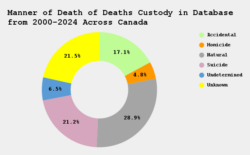Post #248
900 words; 4 minutes to read
Audio summary by volunteer Kimberly Duong.
Summary: A new Canadian project and website provide information on more than 2000 deaths over the last 20 years in jails and prisons and in interactions with police.
Since the year 2000, more than 2100 people have died in Canada either in contacts with police, or in prisons and other custodial settings. That’s about 100 people a year on average, dying in situations where they are not supposed to.
Some of these stories have drawn a lot of public attention – for example the supremely tragic case of Ashley Smith, or the more recent case of Soleiman Faqiri.
However those are the exceptions. Most of these deaths occur without public notice. The circumstances are often hidden. We may only be told the version that the police or prison wants to be told.
Until now nobody has been tracking how many such deaths occur, who dies, and under what circumstances.
Now a new Canadian research project has put together and made public as much data as possible on all those deaths, drawing public attention to an area that has been far too secretive.
As the project notes, The lack of data prevents researchers, policy-makers, advocates, and communities most impacted by police violence from answering basic questions about police use of force, police-involved deaths, and deaths in custody.
Tracking (in)justice
Tracking (in)justice is a Canadian project involving several universities and community partners that has, with a huge amount of work, put together a data base of all know deaths in custody in Canada since the year 2000. That includes people who died during involvement with police or in jail or prison, or in other custodial setting.
This project aims to provide access to data and analysis so individuals, organizations and communities can collectively advocate, shape policy and create accountability.
Hard to find accurate data
Finding the cases to add to the database is not easy, precisely because there is no standard for what is made public when these incidents occur. The researchers use google alerts and regular and ongoing online searches to find cases and then add information about each case from publicly available sources, including government reports, press releases and accredited Canadian media sources. ‘We only add information into the spreadsheet from either government sources, oversight body sources, or accredited media sources.’ However often important aspects of a case are not reported in these public ways, so in some cases there is a significant amount of missing data.
As well, Sometimes what the media or government present as ‘facts’ are contested or are entirely incorrect. We accept this as a limitation of the project as it currently stands. The authorities – police or prison officials – regularly distort or lie about cases to protect themselves, as has been found in a number of coroners’ inquiries and other investigations.
More than a registry
The site and project go beyond simply finding and cataloguing data, however. It is well known that those who die in these circumstances are very disproportionately people from marginalized communities, a fact that needs greater recognition.
As well, the site seeks to show how the people whose names are on it are not just cases or statistics, but real people with loved ones who suffered from what happened to them. The site includes some audio recordings of people talking about their sense of loss when a loved one died, and their belief that in many cases the authorities do not take these deaths seriously. The site includes some resources for those bereaved.
Friends and family members can also contribute information in memory to the project about those who died.
We are also working to consult families and communities to help identify ways to understand the limitations of the current data, and examine ways it can be better presented, analyzed, or identified as incorrect and biased.
Data open to others
Another key purpose of the project is for the data to be used by others – researchers and community members – to bring further awareness to the cases and the larger issues involved. All the data are available for further analysis.
People can search the database using the variables on our website’s Explore the Data page to create their own analysis. For example, to get a snapshot of how many people have died in each institution, you can search the deaths by institution in which they occurred. Or, to understand patterns over time, you can search by date, and manner of death, or other factors such as gender, or type of custody.
A few initial findings
The research team also posts occasional blogs with some of the initial findings. For example, these two graphs show that a large proportion of deaths in custody are not explained, but that most are not from natural causes. Many are due to suicide or drug overdoses, and a significant number due to murders.
This data base and website are an important contribution to a better understanding of criminal justice issues in Canada and in particular to the ways in which authority can be abused creating very serious harms that may never be acknowledged. They also show what can happen when there is collaboration between researchers and community members.
Overall this is an important project that deserves public attention and support.
The John Howard Canada blog is intended to support greater public understanding of criminal justice issues in Canada. Blog content does not necessarily represent the views of John Howard Society of Canada. All blog material may be reproduced freely for any non-profit purpose as long as the source is acknowledged. We welcome comments (moderated) and suggestions for content. Contact: blogeditor@johnhoward.ca
Back



Comments are closed here.